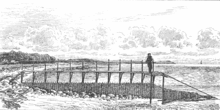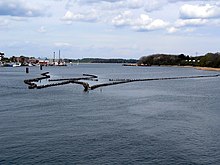Fish fence
The fish fence , also fish groyne , agge or arge ( English called fish weir or fish trap ) is a device for passive fishing that has been used worldwide since the Mesolithic in rivers, lakes and suitable coastal areas . Mass trapping in the vicinity of seasonal living spaces can be assumed in Europe since the Mesolithic. The residents of rivers, coasts and lakes enriched their diet with fish after the departure of the large herd animals.
The fish fence is available as a wattle wall fence or, more rarely, as a fish wall (as in Strangford Lough in Northern Ireland ) or “stone fish fence” (e.g. in African wadis ). Some peoples on the northwest coast of America, such as the Eskimos , Tlingit , Kwakiutl, and Haida, subsisted almost exclusively on fishing.
Demarcation
A fish weir , on the other hand, is a modern device in waters that is used to determine the migratory fish species.
Finds
Denmark
In Denmark , over 100,000 fish bones have been found on 14 coastal and two inland sites of the Ertebølle culture . The fishery was mainly carried out using fixed fish traps (Danish: Fiskegærde or Ålegård), with which uncritical quantities of the local fish fauna were caught. Ålegård is an old fishing method that was used in Denmark in rivers ( Gudenå , Skjern Å ) and along the coast where nets were difficult to use. It consisted of a fish fence made of branches perpendicular to the direction of flow or seaward, which led the eel to a trap at the end of the fence. They were often provided with a jetty so that a boat would not be needed to retrieve the catch.
At the southern end of the island of Nekselø north of Kalundborg , a 200 m long fish fence extends from the beach into the sea to about 2.5 m today's water depth. Another fish fence was found at Oleslyst near Korsør . In the drained fjord, the site has excavated the only major fishing system to date. A 5.5 m long braided hazelnut fence has been preserved from the complex and a 40 m long row of net poles was found. There is much evidence that the complex dates back to the Neolithic Age.
Germany
Of the different fish species, 41 have been identified on the coast and 15 inland. The subsistence economy based on marine resources on the seasonal use. At the “Timmendorf-Nordmole” site, a settlement site of the Ertebølle culture on the coast of the island of Poel , sprouts, remains of fish fences, antler harpoons , paddles and fragments of a dugout canoe point to this.
In the Arendsee in Saxony-Anhalt and near Neustadt in Holstein the remains of long fish fences from the Neolithic were found.
In 1988, fish fences were discovered in the watt near Ehst, east of Sankt Peter-Ording . The fences, with a wicker wall basket at the end, were documented in 2002. According to radiocarbon dates, they belong to the 16th or 17th century. Similar constructions are from the English Wadden Sea, u. a. the "Severn Estuary" and the Irish Fergus Estuary known (Boarland Rock 2 in the north of Coney Island).
In the Wadden Sea fish fences were used until the 20th century. Mostly they were referred to as "fish gardens". They were set up in the troughs in such a way that the fish were led into the traps at the end of the fence when the water ran out. Flatfish and garfish were mostly caught in this way. In Foehr there were some fish gardens by the end of the 20th century.
Kappeln
The 600-year-old herring fence from Kappeln in fishing or Schwansen is the last to have been preserved from more than 40 on the Schlei . It is considered the last in Germany, probably even in Europe. The rights to the fence were transferred to the city by the Duke of Schleswig-Holstein in 1977 . Today the herring fence in Kappeln is fully functional and is maintained by the beautification association. Herring is caught again on the fence on the Kappelner Herring Days.
France
A map of the Seine and its tributaries drawn up in 1738 by the Abbé Delagrive (1689–1757) recorded seven fish fences ( French pêcherie en bois or Écluses à poissons - fish walls ) on a six-kilometer section of the Oise . On the beach at Hauteville-sur-Mer in the Manche department in Normandy, there is a centuries-old wooden fish trap in operation. There are only five active timber fisheries left in Europe.
Great Britain
In Britain, the traditional form was one or more rock weirs in tidal gullies or on a sandy beach, with a small gap that could be blocked by wattle fences. Examples, which are no longer in use, liegn in the Menai Straits ( fish fences of Aberlleiniog ) in Wales see. Other examples are Rhos Fynach in North Wales and Scotland's Haven in Caithness . In the second half of the 20th century numerous fixed weirs installed for fishing failed across Wales. In addition to fixed traps, Wales had a number of removable traps known as "Crucks", "Cribs", "Inscale" and "Mist". The basket traps used at Goldcliff and Porton in the Severn Estuary are called "Putchers". Finiskaig is a fragmentary stone arch in the shallows at the end of Loch Nevis near Glenelg in the Highlands.
Ireland
One of Europe's best preserved medieval fish fences is in the Fergus Estuary in County Clare , Ireland . A 9,000 year old Neolithic fish trap was found during excavations along M3 in Clowanstown near Dunsany in County Meath near the Hill of Tara in 2009 . Settlement remains of an agricultural, industrial and ritual nature have been discovered under five artificial hills next to an ancient lake. Stone axes, jewelry and a small wooden canoe were unearthed.
United States
The "Boylston Street Fishweir" in the Back Bay district of Boston , Massachusetts , is an archaeologically well-researched prehistoric fish trap in the USA.
literature
- Inge Bødker Enghoff: Fishing in Denmark during the Ertebølle periods. In: International Journal of Osteoarchaeology. Vol. 4, No. 2, 1994, ISSN 1047-482X , pp. 65-96, doi : 10.1002 / oa.1390040203 .
- Nigel Bannerman, Cecil Jones: Fish-trap types: a component of the maritime cultural landscape In: International Journal of Nautical Archeology. Vol. 28, No. 1, 1999, ISSN 1057-2414 , pp. 70-84, doi : 10.1111 / j.1095-9270.1999.tb00823.x .
- JG Jenkins: Commercial Salmon Fishing in Welsh Rivers. Folk Life - Journal of the Society of Folk Life Studies, Vol. 9, 1971
- Jutta Kollbaum-Weber: Historical hunting and fishing methods on the island of Föhr and in the Uthlanden (= booklet to the natural history department of the Dr.-Carl-Haeberlin-Friesen-Museum. Vol. 1 = series of publications by Dr.-Carl-Haeberlin-Friesen -Museum, Föhr. NF issue 22). Husum Druck- und Verlagsgesellschaft, Husum 2007, ISBN 978-3-89876-343-1 , pp. 69-74.
- Paul Montgomery: Intertidal Fish Traps from Ireland: Some Recent Discoveries in Lough Swilly, Co. Donegal In: Journal of Maritime Archeology 10 (2) 2015
- Martin Rheinheimer : The bunk man. Man and nature in the Wadden Sea. 1860–1900 (= North Frisian sources and studies. Vol. 7). Wachholtz, Neumünster 2007, ISBN 978-3-529-02776-5 , pp. 154-163.
Web links
- Kappeln
- Poel Island
- Boston Fish Weir
- Fish fence in the Arendsee
- Medieval Welsh fish weirs
- Stone Age coastal fishing in Denmark
- Pictures from Rhos Fynach
- Image of the fish wall at Kerr Moor
- Video: building and fishing a herring fence . Institute for Scientific Film (IWF) 1995, made available by the Technical Information Library (TIB), doi : 10.3203 / IWF / D-1890 .
- Ireland
Individual evidence
- ^ Martin Rheinheimer: Der Kojenmann. Man and nature in the Wadden Sea. 1860–1900 (= North Frisian sources and studies. Vol. 7). Wachholtz, Neumünster 2007, ISBN 978-3-529-02776-5 , pp. 154-163; Jutta Kollbaum-Weber: Historical hunting and fishing methods on the island of Föhr and in the Uthlanden. Husum Druck- und Verlagsgesellschaft, Husum 2007, ISBN 978-3-89876-343-1 , pp. 69-74.






